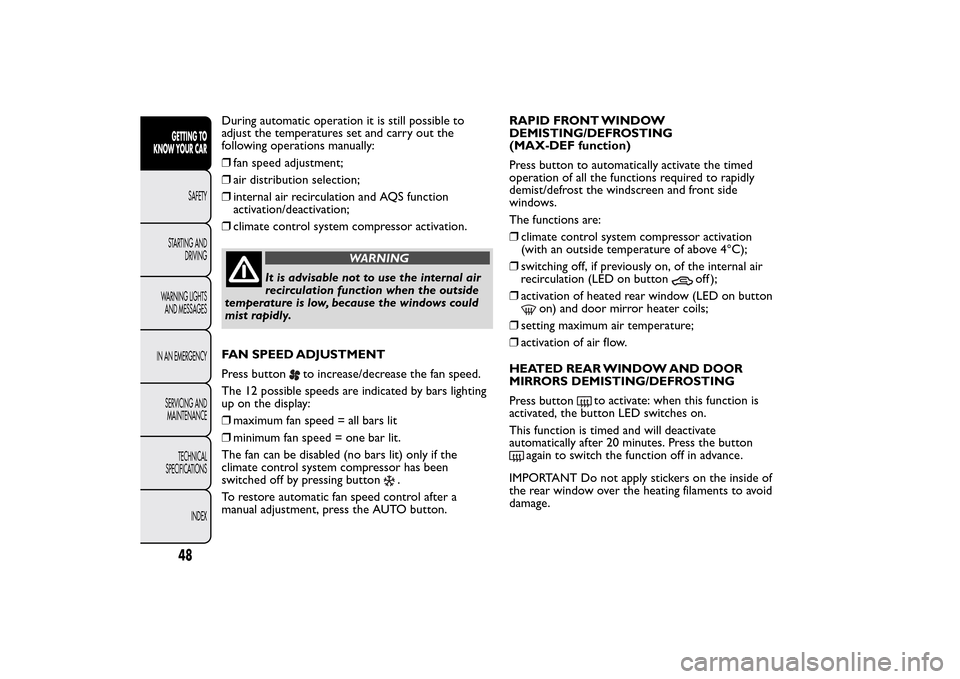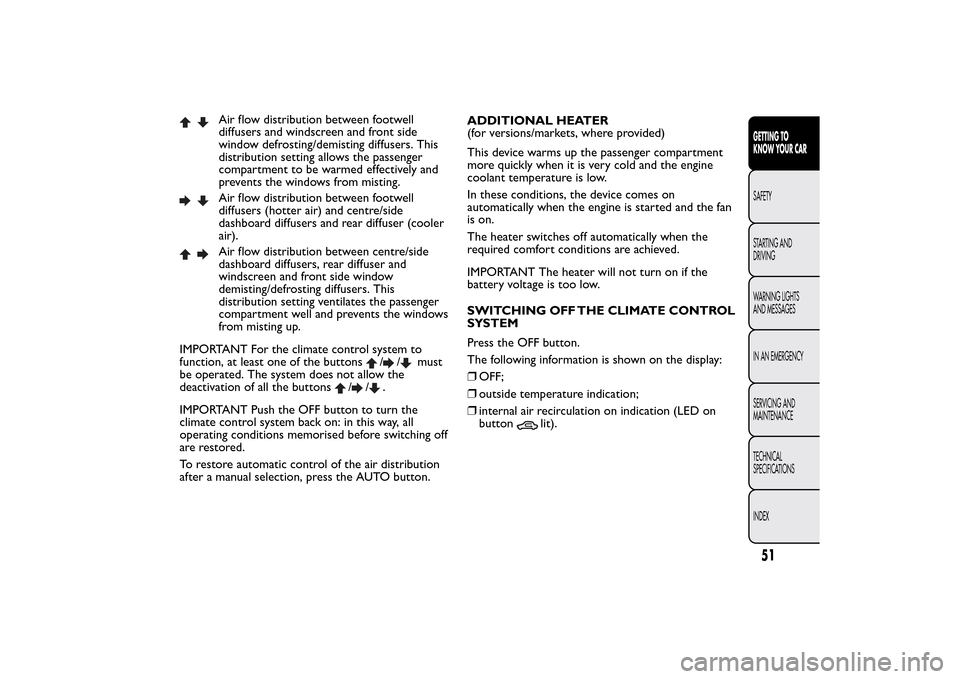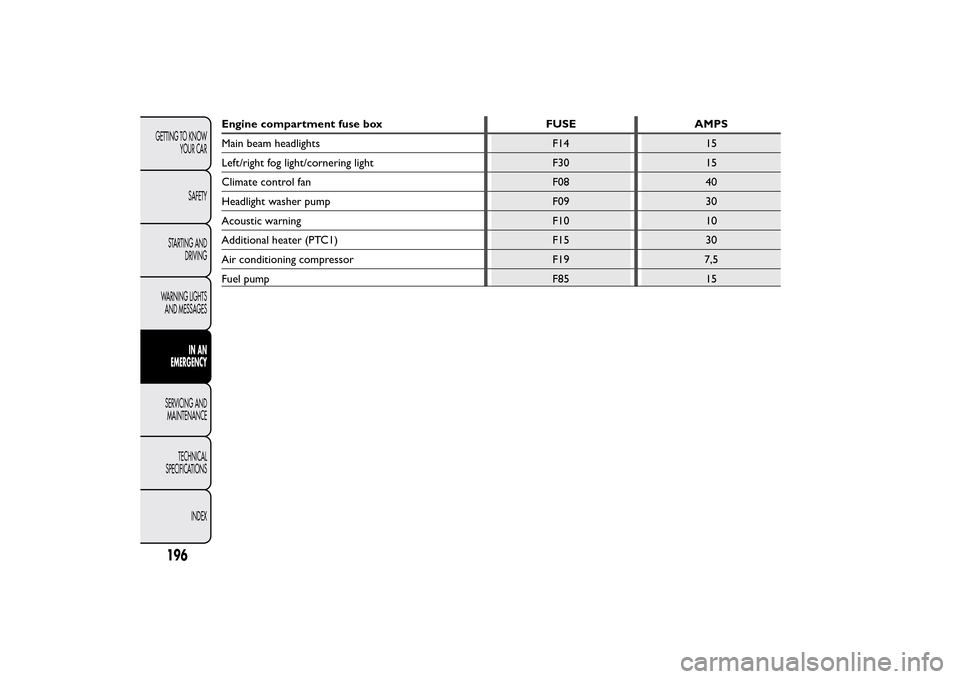2014 FIAT BRAVO heater
[x] Cancel search: heaterPage 45 of 275

FAN SPEED ADJUSTMENT
To ventilate the passenger compartment properly,
proceed as follows:
❒fully open the central and side air diffusers;
❒turn knob A to the blue section;
❒turn knob C to the required speed;
❒turn knob E to
;
❒turn off internal air recirculation (LED on button
off ).
INTERNAL AIR RECIRCULATION
ACTIVATION
Press button
: when the function is on, the
button LED lights up. It is advisable to switch the
internal air recirculation on while standing in queues
or in tunnels to prevent the introduction of polluted
air. However, it is better not to use the function
for long periods, particularly if there are many people
on board, to prevent the windows from misting.
IMPORTANT Internal air recirculation makes it
possible to reach the required heating or cooling
conditions more quickly depending on the mode
selected. Do not use the internal air recirculation
function on rainy/cold days as it would considerably
increase the possibility of the windows misting.ADDITIONAL HEATER
(for versions/markets, where provided)
This device warms up the passenger compartment
more quickly when it is very cold and the engine
coolant temperature is low.
The additional heater comes on automatically when
the engine is started, if knob A is turned to the
last red sector and the fan (knob C) is at least at the
first speed level.
The heater switches off automatically when the
required comfort conditions are achieved.
IMPORTANT The heater will not turn on if the
battery voltage is too low.
41GETTING TO
KNOW YOUR CARSAFETY
STARTING AND
DRIVING
WARNING LIGHTS
AND MESSAGES
IN AN EMERGENCY
SERVICING AND
MAINTENANCE
TECHNICAL
SPECIFICATIONS
INDEX
Page 49 of 275

ADDITIONAL HEATER
(for versions/markets, where provided)
This device warms up the passenger compartment
more quickly when it is very cold and the engine
coolant temperature is low.
The additional heater comes on automatically when
the engine is started, if knob A is turned to the
last red sector and the fan (knob C) is at least at the
first speed level.
The heater switches off automatically when the
required comfort conditions are achieved.
IMPORTANT The heater will not turn on if the
battery voltage is too low.SYSTEM MAINTENANCE
In winter, the climate control system must be turned
on at least once a month for about 10 minutes.
Before summer, have the system checked at a Fiat
Dealership.
45GETTING TO
KNOW YOUR CARSAFETY
STARTING AND
DRIVING
WARNING LIGHTS
AND MESSAGES
IN AN EMERGENCY
SERVICING AND
MAINTENANCE
TECHNICAL
SPECIFICATIONS
INDEX
Page 52 of 275

During automatic operation it is still possible to
adjust the temperatures set and carry out the
following operations manually:
❒fan speed adjustment;
❒air distribution selection;
❒internal air recirculation and AQS function
activation/deactivation;
❒climate control system compressor activation.
WARNING
It is advisable not to use the internal air
recirculation function when the outside
temperature is low, because the windows could
mist rapidly.
FAN SPEED ADJUSTMENT
Press button
to increase/decrease the fan speed.
The 12 possible speeds are indicated by bars lighting
up on the display:
❒maximum fan speed = all bars lit
❒minimum fan speed = one bar lit.
The fan can be disabled (no bars lit) only if the
climate control system compressor has been
switched off by pressing button
.
To restore automatic fan speed control after a
manual adjustment, press the AUTO button.RAPID FRONT WINDOW
DEMISTING/DEFROSTING
(MAX-DEF function)
Press button to automatically activate the timed
operation of all the functions required to rapidly
demist/defrost the windscreen and front side
windows.
The functions are:
❒climate control system compressor activation
(with an outside temperature of above 4°C);
❒switching off, if previously on, of the internal air
recirculation (LED on button
off );
❒activation of heated rear window (LED on button
on) and door mirror heater coils;
❒setting maximum air temperature;
❒activation of air flow.
HEATED REAR WINDOW AND DOOR
MIRRORS DEMISTING/DEFROSTING
Press button
to activate: when this function is
activated, the button LED switches on.
This function is timed and will deactivate
automatically after 20 minutes. Press the button
again to switch the function off in advance.
IMPORTANT Do not apply stickers on the inside of
the rear window over the heating filaments to avoid
damage.
48GETTING TO
KNOW YOUR CAR
SAFETY
STARTING AND
DRIVING
WARNING LIGHTS
AND MESSAGES
IN AN EMERGENCY
SERVICING AND
MAINTENANCE
TECHNICAL
SPECIFICATIONS
INDEX
Page 55 of 275

Air flow distribution between footwell
diffusers and windscreen and front side
window defrosting/demisting diffusers. This
distribution setting allows the passenger
compartment to be warmed effectively and
prevents the windows from misting.Air flow distribution between footwell
diffusers (hotter air) and centre/side
dashboard diffusers and rear diffuser (cooler
air).Air flow distribution between centre/side
dashboard diffusers, rear diffuser and
windscreen and front side window
demisting/defrosting diffusers. This
distribution setting ventilates the passenger
compartment well and prevents the windows
from misting up.
IMPORTANT For the climate control system to
function, at least one of the buttons
/
/
must
be operated. The system does not allow the
deactivation of all the buttons
/
/
.
IMPORTANT Push the OFF button to turn the
climate control system back on: in this way, all
operating conditions memorised before switching off
are restored.
To restore automatic control of the air distribution
after a manual selection, press the AUTO button.ADDITIONAL HEATER
(for versions/markets, where provided)
This device warms up the passenger compartment
more quickly when it is very cold and the engine
coolant temperature is low.
In these conditions, the device comes on
automatically when the engine is started and the fan
is on.
The heater switches off automatically when the
required comfort conditions are achieved.
IMPORTANT The heater will not turn on if the
battery voltage is too low.
SWITCHING OFF THE CLIMATE CONTROL
SYSTEM
Press the OFF button.
The following information is shown on the display:
❒OFF;
❒outside temperature indication;
❒internal air recirculation on indication (LED on
button
lit).
51GETTING TO
KNOW YOUR CARSAFETY
STARTING AND
DRIVING
WARNING LIGHTS
AND MESSAGES
IN AN EMERGENCY
SERVICING AND
MAINTENANCE
TECHNICAL
SPECIFICATIONS
INDEX
Page 144 of 275

Electric devices
Use electrical devices only for the amount of time
necessary. The heated rear window, additional
headlights, windscreen/rear window wipers and
heater fan need a considerable amount of energy,
therefore increasing fuel consumption (by up to 25%
in the urban cycle).
Climate control system
Air conditioning leads to higher fuel consumption (on
average up to +20%). If the temperature outside
permits, try and use the air vents.
Spoilers
The use of non-certified spoilers may adversely affect
air drag and fuel consumption.DRIVING STYLE
The main driving styles that affect fuel consumption
are listed below.
Starting
Do not warm the engine with the car at a standstill
or at idle or high speed: under these conditions
the engine warms up much more slowly, increasing
electrical consumption and emissions. It is therefore
advisable to move off immediately, slowly, avoiding
high speeds: in this way the engine will warm faster.
Unnecessary actions
Avoid accelerating when starting at traffic lights or
before switching off the engine. This and also double
declutching is absolutely pointless on modern cars
and also increases consumption and pollution.
Gear selection
As soon as the conditions of the traffic and road
allow, use a higher gear. Using a low gear for faster
acceleration will increase consumption.
In the same way improper use of a high gear
increases consumption, emissions an engine wear.
Max. speed
Fuel consumption increases considerably with speed.
Maintain a constant speed, avoiding unnecessary
braking and acceleration, which cost in terms of both
fuel consumption and emissions.
140GETTING TO KNOW
YOUR CAR
SAFETYSTARTING AND
DRIVINGWARNING LIGHTS
AND MESSAGES
IN AN EMERGENCY
SERVICING AND
MAINTENANCE
TECHNICAL
SPECIFICATIONS
INDEX
Page 200 of 275

Engine compartment fuse box FUSE AMPS
Main beam headlights F14 15
Left/right fog light/cornering light F30 15
Climate control fan F08 40
Headlight washer pump F09 30
Acoustic warning F10 10
Additional heater (PTC1) F15 30
Air conditioning compressor F19 7,5
Fuel pump F85 15
196GETTING TO KNOW
YOUR CAR
SAFETY
STARTING AND
DRIVING
WARNING LIGHTS
AND MESSAGES
IN AN
EMERGENCY
SERVICING AND
MAINTENANCE
TECHNICAL
SPECIFICATIONS
INDEX
Page 269 of 275

INDEX
A
BS (system) .............................. 89
Accessories purchased by
the owner ................................... 96
Activation/Deactivation
(CITY function) ......................... 97
Activation of internal air
recirculation and
enablement of AQS
function (Air Quality
System)........................................ 49
Additional heater ............. 41-45-51
Adjustable side vents and
diffusers....................................... 37
Air cleaner ................................... 212
Air distribution selection .......... 50
Alarm ............................................. 14
Anti-pinch safety device ............ 74
Ashtray .......................................... 70
ASR (system) ............................... 93
Automatic dual zone climate
control system .......................... 46
Automatic headlight sensor
(dusk sensor) ............................. 54
Automatic operation of the
climate control system
(AUTO function) ...................... 47
Battery ........................................ 212
– advice for extending
lifetime .................................... 212
– replacement ........................... 212
Battery (recharging) .................. 198
Bodywork
– maintenance .......................... 220
– protection against
atmospheric agents.............. 219
– warranty ................................. 219
Bonnet........................................... 85
Brake Assist ................................. 91
Brake fluid.................................... 210
Brakes
– specifications ......................... 231
ulb replacement ............... 180-182
Bulb replacement
– exterior lights ....................... 177
– interior lights......................... 184
Bulbs
– bulbs (replacement) ............. 174
– general instructions ............. 174
– types of bulbs ........................ 175
Capacities.................................... 242
Car dimensions .......................... 239
Cargo Box .................................... 85
Carrying children safely ............ 116
– child restraint systems ........ 124
– "Isofix" child restraint
system setup ......................... 122
Central diffusers ......................... 37
Central locking ............................ 75
Changing a wheel ....................... 162
Checking fluid levels.................. 206
Child lock device ........................ 75
Child restraint systems
(compliance for use) ............... 121
Cigar lighter ................................. 69
Cleaning and maintenance
– bodywork ............................... 219
– car interior............................. 222
– engine compartment ........... 221
– front headlights ..................... 221
– Plastic and coated parts...... 223
– seats ................................ 222-223
– windows ................................. 221
Climate control/heating
system ......................................... 36
265GETTING TO KNOW
YOUR CAR
SAFETY
STARTING AND
DRIVING
WARNING LIGHTS
AND MESSAGES
IN AN EMERGENCY
SERVICING AND
MAINTENANCE
TECHNICAL
SPECIFICATIONSINDEX
B